10/1/2023
Why Did I Wait So Long?
Chris Beytes
Here’s a question for you: Is there a greenhouse tool or technology that you resisted investing in, for whatever reason, and now it works so well that you kick yourself for not buying it sooner?
GrowerTalks put that question to a dozen growers who we know have invested in a lot of tools and technologies over the years. The answers were varied and spirited—and plentiful! So plentiful, in fact, that we’re splitting this article across two issues so’s not to have to leave any detail on the cutting-room floor. Here’s what six of our growers told us about 11 of their favorite “Why-did-I-wait-so-long?” tools.
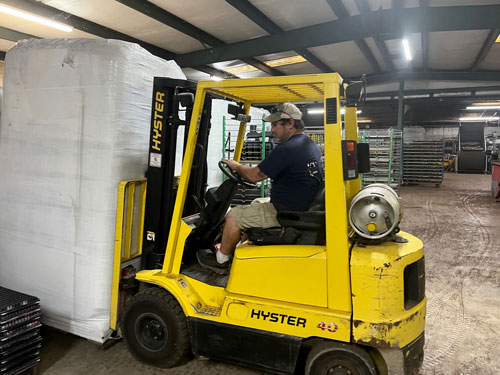
Davy Wright, Wright’s Nursery & Greenhouse—Plantersville, Alabama
“That’s an interesting topic!” replied Davy. “David [his father] and I were discussing that very thing last week. There are a few growers near us that the previous generation resisted change and now the next generation is barely holding on. Thank goodness David was not one of those, and he realized that even if he didn’t understand the technology, I would—especially things that could not be fixed with his favorite tool—the hammer! We’ve most always been ahead of the norm when it comes to technology.”
However, one of their most-resisted pieces of equipment could hardly be called high-tech: it’s their forklift.
“We had the setup for one in the late ’80s, but never purchased one until the late ’90s,” Davy recalls. “Unloading a truck with a manual pallet jack would take several hours and was backbreaking. I was fortunate enough not to have to unload many of those trucks because I wasn’t big enough to move a 1-ton pallet.”
The main reason for the resistance was based on the simple cost of the machine, but what they neglected to calculate was the non-monetary cost to their health.
“David says [the manual pallet jack] cost him and Ed [a 49-year veteran of Wright’s] time they could have spent on something else, and as they have gotten older, they realize it cost them part of their health.”
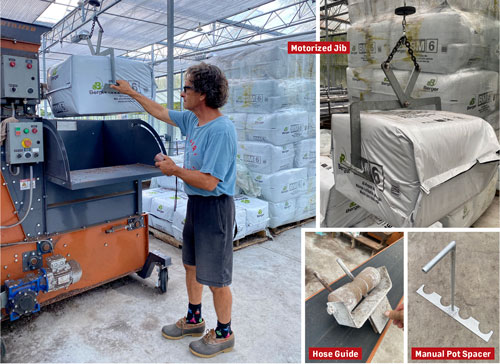
Daniel Gravano, Gravano Farms—Ruffin, South Carolina
We liked Dan Gravano’s three choices because they’re straight from his own ingenious mind, low in cost and any grower can copy them.
The first is a motorized jib for moving 3.8 cu.-ft. bales of potting mix to the pot filler. He designed it in AutoCAD and had a shop plasma-cut and hot-dip galvanized the parts. It uses an off-the-shelf remote winch that slides along an I-beam bolted to the greenhouse trusses over the soil processing equipment. Watch Dan HERE.
Innovation #2 is a hose guide that keeps his spray hose from getting stuck on the corners of the gutters when he’s on the roof cleaning or applying shade to the glass. Made from a boat trailer rubber guide and a steel U-channel, it clamps to the front edge of the roof gutter, keeping Dan’s 300-ft. hose moving free and straight, and making the job of cleaning the roof glass a lot less dangerous.
Lastly is something we’ve seen many times before but never get tired of: a manual pot spacer. This does 4.5-in pots on 8-in. centers. Dan had a fabricator waterjet his design out of aluminum and said, “They work perfectly and save one’s back from repetitive spacing on the floor.”
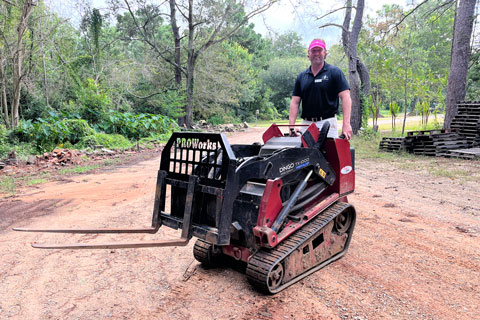
JD Boone, Dothan Nurseries—Dothan, Alabama
Dothan Nurseries is a retail garden center, but that doesn’t mean they can’t invest wisely in tools. Owner JD Boone said when it comes to machinery, it’s definitely their Toro Dingo, which they use for planting trees. That’s JD showing it off in the photo on the next page.
“The Dingo turns a one-man, one- or two-hour job into a 30-minute job. And it turns a two-man job into a one-man job. But we still charge for the two-man or two-hour even if it doesn’t take as long,” he said. “We charge for the job, not the time. Makes it so much easier to plant a tree, move a fountain, etc.”
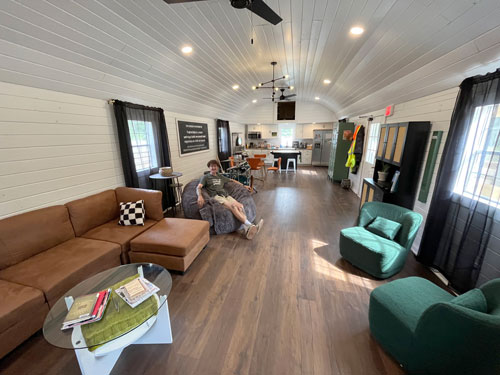 Speaking of machines like Dingos, JD has learned buying new beats buying used every time.
Speaking of machines like Dingos, JD has learned buying new beats buying used every time.
“Rather than pouring money into an old tractor or forklift, never knowing when it is going to break down, I now try to buy new every five to seven years. Fewer headaches, and we can focus on doing our job, not fixing a tractor or forklift.”
Lastly, something that JD didn’t resist investing in: a new breakroom with a kitchen, bean bag chairs, couches, a record player—even guitars and a drum set (his own, from home … which his family probably appreciates). That’s Cody Kopkie enjoying the new space.
“We simply outgrew our other one,” he said. “Employees love it. They can really relax and break away from the nursery.”
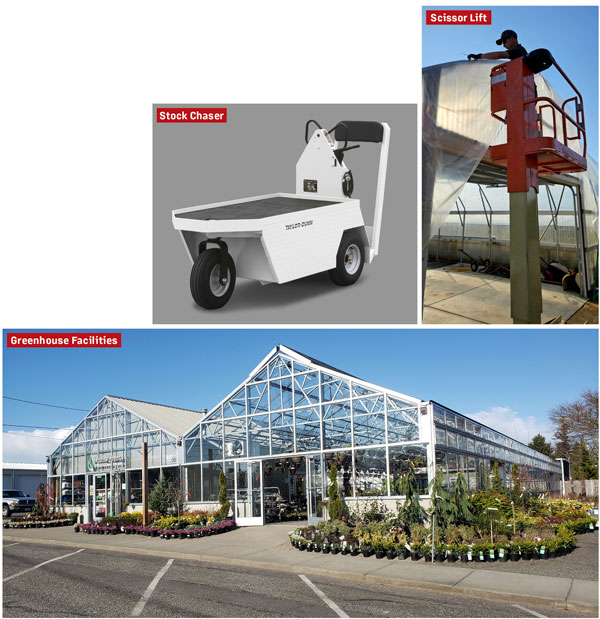
David Vos, Vander Giessen Nursery—Lynden, Washington
Vander Giessen is a self-described “pretty small” operation, without a lot of technology or automation, but they’ve made a few “how-did-we-live-without-it?” investments over the last 10 years, said manager David Vos, including:
Greenhouse facilities. Ten years ago, they upgraded their 75-year-old wood-and-glass greenhouses to a modern Nexus Vail Atrium facility.
David said, “Having higher gutter heights, a more open floor plan, better ventilation and automated climate control has been a game-changer for our business, and already in the first year after construction we could see that our old facilities had been holding us back in terms of the quality of product we could produce and the amount of customers we could serve. We took several years to research and choose the right product to meet our needs and vision, but I wish we’d started the process years earlier.”
Scissor lift. Several years ago, Vander Giessen decided to purchase a scissor lift to aid in safely maintaining and servicing their greenhouses and warehouse facilities. “I don’t know how we ever did without,” said David. “Ladders are fine in a lot of instances, but if you want to work in comfort and without fear of falling, invest in a lift.”
Stockchaser. The next smart decision for Vander Giessen? A Taylor-Dunn Stockchaser they saw at the recent Farwest show in Portland, Oregon, for transporting plants and hardgoods between buildings.
“My guess (and hope!) is that this will be the next thing we wonder how we ever lived without,” said David. “We’ve always just made do with manual carts and wagons, but in the busy spring season we’re tired enough as it is without having to push a cart back and forth between greenhouses a hundred times a day, so I’m hoping we find this a very worthwhile investment.”
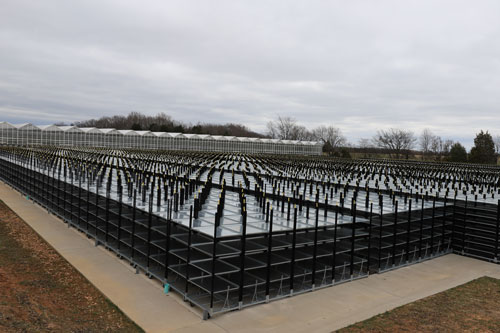
Alex Van Der Hengst, South Central Growers—Springfield, Tennessee
For South Central, it was switching to a more efficient shipping cart, said co-owner Alex.
“We had almost 10,000 22-in. x 57-in. carts and just couldn’t wrap our minds around spending $3.6 million to switch to the 31-in. x 44-in. cart,” Alex said. “We figured the ROI was plus or minus 10 years. It ended up being 18 months.”
Alex said the fast payback came from freight savings (which were significant), but even more so from the overall efficiency of their shipping department.
“We went from having to pull and deliver 1,000 carts per day to 750,” he explained. “What we didn’t account for is that it takes no longer to load the new cart, push the new cart on the truck and so on as it did the old one.”
As for his regrets?
“Wish we would have made the change when we had around 4,000 of the old carts, but at least we didn’t wait until we had 15,000 of them!”
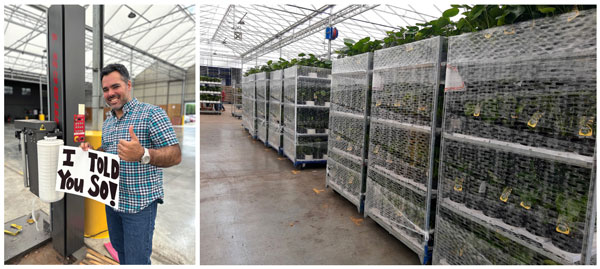
Dave Van Belle, Van Belle Nursery—Abbotsford, British Columbia
Like most of our respondents, Dave Van Belle said he probably has half a dozen “why-did-I-wait-so-long” investments, but one that came immediately to mind was their pallet wrapper for applying shrink wrap to shipping racks and wooden pallets.
Dave said they were wrapping hundreds of racks and pallets by hand every day. Operations Manager Pablo Costa, who came to Van Belle from Chile seven years ago, didn’t like the process.
“The first thing I thought was nobody really wanted to do this job; it’s definitely the least-desirable task to do. I wrapped a few racks by hand and I knew right away why! I knew there had to be a better way.” Pablo suggested they invest in a mechanized pallet wrapper to streamline the job.
Recalls Dave, “I was against it because of cost [about $10,000 each]. And I didn’t think they would be very efficient because I was imagining a bottleneck in the shipping process. And at that time, if we needed something to get wrapped, anyone could grab a roll of shrink wrap and get it done—super flexible!” Dave also imagined that if they had a person “in charge” of wrapping that person would be standing around, watching the machine until it was finished, and thus be wasting time.
But Pablo persisted. Dave relented. Pablo found a place that rented them and they brought in three to try out.
“Boy, was I ever wrong!” Dave happily admits. “Cost wasn’t an issue because of renting [about $1,000/month or so]. There were no bottlenecks. The machines kept up no problem. And one guy could easily manage to keep three machines spinning.”
In addition, product is wrapped better and more consistently, with the same amount of wrap (which equals savings). And, last but not least, employees don’t get dizzy—“It’s a bit of a ‘respect people’ thing for us, one of our core values.”
Dave admits to eating some humble pie with this one, but he’s glad Pablo persisted. They buy one machine per year and now own four, and rent the rest.
“I’m glad I have a stubborn operations manager,” joked Dave. “Dutch people aren’t the only stubborn ones!” GT